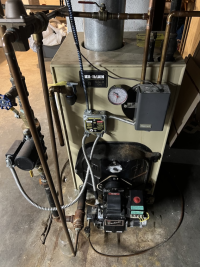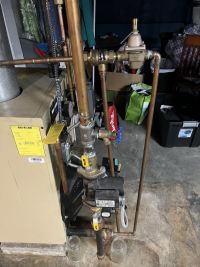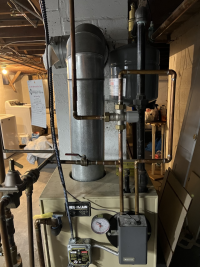Yanks02026
New Member
Hello,
A buddy and I replaced the mixing valve on my furnace (combo for baseboard heating and hot water) the other day. For some reason the prior owners had removed the old mixing valve (found it laying in the basement and it was pretty crusty but maybe now the problems I'm having that is why it was removed), so i was tired of hot water in the house coming out around 170. So we installed the new mixing valve and everything seemed to be fine. But later that evening I noticed water on the ground. So now the pressure relief valve releases a small amount of water sometimes. Some water is also released from the feed water pressure regulator/backflow preventer. I just watched the furnace during the heating of the house and the pressure did get up to around 32 on the gauge but didnt release water even though the pressure relief valve is 30 PSI. But I'm guessing this is the cause for the water being released. I have set the temperature to a high of 180 and a low of 160 with a 20 DIFF. Before adding the mixing valve I never had problems with the water being released, so im sure there was never problems of high pressure.
My boiler is a Weil McLain gold oil and probably from the mid 2000's. So its on the end of its life probably but never had problems in the year that I've lived in the house. Also encase it matters I did install a Smart Nest but it worked fine since changing that.
A buddy and I replaced the mixing valve on my furnace (combo for baseboard heating and hot water) the other day. For some reason the prior owners had removed the old mixing valve (found it laying in the basement and it was pretty crusty but maybe now the problems I'm having that is why it was removed), so i was tired of hot water in the house coming out around 170. So we installed the new mixing valve and everything seemed to be fine. But later that evening I noticed water on the ground. So now the pressure relief valve releases a small amount of water sometimes. Some water is also released from the feed water pressure regulator/backflow preventer. I just watched the furnace during the heating of the house and the pressure did get up to around 32 on the gauge but didnt release water even though the pressure relief valve is 30 PSI. But I'm guessing this is the cause for the water being released. I have set the temperature to a high of 180 and a low of 160 with a 20 DIFF. Before adding the mixing valve I never had problems with the water being released, so im sure there was never problems of high pressure.
My boiler is a Weil McLain gold oil and probably from the mid 2000's. So its on the end of its life probably but never had problems in the year that I've lived in the house. Also encase it matters I did install a Smart Nest but it worked fine since changing that.



